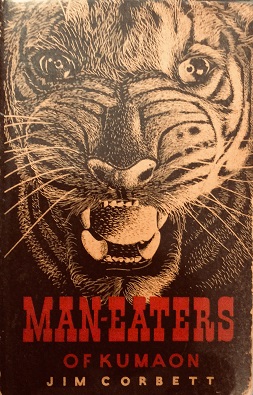Man-Eaters of Kumaon
Man-Eaters of Kumaon is a book written by Jim Corbett, a British hunter, tracker, naturalist, and author. The book details Corbett's experiences hunting man-eating tigers and leopards in the Kumaon region of India during the early 20th century. First published in 1944, Man-Eaters of Kumaon has become a classic in the field of wildlife literature, offering insights into the behavior of man-eaters and the techniques Corbett used to track and kill them.
Synopsis[edit | edit source]
Man-Eaters of Kumaon comprises ten chapters, each dedicated to a specific man-eating tiger or leopard that Corbett tracked and killed. The book begins with an introduction to the region of Kumaon, its people, and the circumstances that led to the rise of man-eaters. Corbett provides detailed accounts of his hunts, which are not only thrilling narratives but also offer observations on the flora and fauna of the Indian subcontinent. He emphasizes the importance of understanding the natural environment and the behavior of animals, as well as the need for conservation.
Themes[edit | edit source]
The book explores themes such as the conflict between humans and wildlife, the balance of nature, and the role of humans in wildlife conservation. Corbett's respect for the animals he hunted and his insights into their behavior have contributed to the book's lasting appeal. He often reflects on the reasons why certain tigers and leopards become man-eaters, pointing to factors such as injury, loss of habitat, and depletion of their natural prey.
Impact and Legacy[edit | edit source]
Man-Eaters of Kumaon has had a significant impact on both literature and conservation. The book's vivid storytelling and detailed descriptions of the Indian wilderness have inspired countless readers and contributed to an increased interest in wildlife conservation. Corbett's advocacy for the protection of India's wildlife led to the establishment of the Jim Corbett National Park in 1957, the first national park in India.
Editions and Adaptations[edit | edit source]
Since its initial publication, Man-Eaters of Kumaon has been reprinted numerous times and translated into several languages. The book's enduring popularity has also led to adaptations in other media, including radio, film, and television.
Criticism[edit | edit source]
While Man-Eaters of Kumaon is celebrated for its contribution to wildlife literature and conservation, it has also faced criticism. Some critics argue that Corbett's narratives reinforce the colonial perspective of the British Empire in India. Others have questioned the ethics of hunting and killing animals, even in the context of man-eaters.
Conclusion[edit | edit source]
Man-Eaters of Kumaon remains a seminal work in the field of wildlife literature, offering a unique blend of adventure, natural history, and conservation. Jim Corbett's legacy as a hunter, conservationist, and author continues to influence the fields of wildlife conservation and literature.
Search WikiMD
Ad.Tired of being Overweight? Try W8MD's physician weight loss program.
Semaglutide (Ozempic / Wegovy and Tirzepatide (Mounjaro / Zepbound) available.
Advertise on WikiMD
|
WikiMD's Wellness Encyclopedia |
| Let Food Be Thy Medicine Medicine Thy Food - Hippocrates |
Translate this page: - East Asian
中文,
日本,
한국어,
South Asian
हिन्दी,
தமிழ்,
తెలుగు,
Urdu,
ಕನ್ನಡ,
Southeast Asian
Indonesian,
Vietnamese,
Thai,
မြန်မာဘာသာ,
বাংলা
European
español,
Deutsch,
français,
Greek,
português do Brasil,
polski,
română,
русский,
Nederlands,
norsk,
svenska,
suomi,
Italian
Middle Eastern & African
عربى,
Turkish,
Persian,
Hebrew,
Afrikaans,
isiZulu,
Kiswahili,
Other
Bulgarian,
Hungarian,
Czech,
Swedish,
മലയാളം,
मराठी,
ਪੰਜਾਬੀ,
ગુજરાતી,
Portuguese,
Ukrainian
Medical Disclaimer: WikiMD is not a substitute for professional medical advice. The information on WikiMD is provided as an information resource only, may be incorrect, outdated or misleading, and is not to be used or relied on for any diagnostic or treatment purposes. Please consult your health care provider before making any healthcare decisions or for guidance about a specific medical condition. WikiMD expressly disclaims responsibility, and shall have no liability, for any damages, loss, injury, or liability whatsoever suffered as a result of your reliance on the information contained in this site. By visiting this site you agree to the foregoing terms and conditions, which may from time to time be changed or supplemented by WikiMD. If you do not agree to the foregoing terms and conditions, you should not enter or use this site. See full disclaimer.
Credits:Most images are courtesy of Wikimedia commons, and templates, categories Wikipedia, licensed under CC BY SA or similar.
Contributors: Prab R. Tumpati, MD

